In Florence, restoration work at the Palazzo del Bargello, home of the Bargello National Museum, has finally been completed: for the first time since the museum’s founding in 1865, when the Bargello was transformed from a prison into the first National Museum dedicated to the arts of the Middle Ages and Renaissance in the Kingdom of Italy, the entire building was restored in record time. That is, in just 15 months, 425 days to be exact, from July 2020 when the first scaffolding was erected until October 2021: so much was needed to put in place the stone facings covering the surface of the main body, the Volognana tower, windows, coats of arms, the courtyard, and the gates. In 156 years, the Bargello Palace had never been restored with a unified project of comprehensive overhaul. The building, built in the mid-13th century, was the subject of a major restoration campaign involving its entirety and involving a meticulous overhaul of the entire monument and all its decorative elements, bringing to light hitherto unknown details. And all this despite the Covid pandemic.
The palace had been the subject of targeted interventions several times in the past decades, but never before had an intervention of this magnitude been put in place, a work that saw more than 12 thousand square meters of pietra forte and pietra serena stone cleaned and consolidated, 128 coats of arms and 124 windows restored (including the monumental window of Donatello’s Salone), as well as the 93 battlements and 199 stone corbels. The intervention, which cost a total of 1 million 800,000 euros, was financed by the Ministry of Culture, through the Interministerial Decree of December 2, 2016 of MiBACT in agreement with MIT (1,150,000 euros), then Ministerial Decree 265 of 04/06/2019 (an additional 450,000 euros), and finally through Ministerial Decree June 9, 2021 (200,000 euros), the latter funding essential to complete the conservative overhaul of the windows. The contract was handled by Invitalia, which acts as the Central Contracting Authority for the Ministry of Culture, and was awarded to the company ITA Consorzio L’Officina - Salvatore Ronga srl. The contract regarding the windows, on the other hand, was awarded to M.V. Polloni Guido e C. snc. The intervention, directed by architect Giancarlo Lombardi under the supervision of architect Maria Cristina Valenti, Single Procedure Manager and head of the Technical Office of the Bargello Museums, saw a team of 24 restorers and skilled workers take part in the work, who took turns during the course of the intervention.
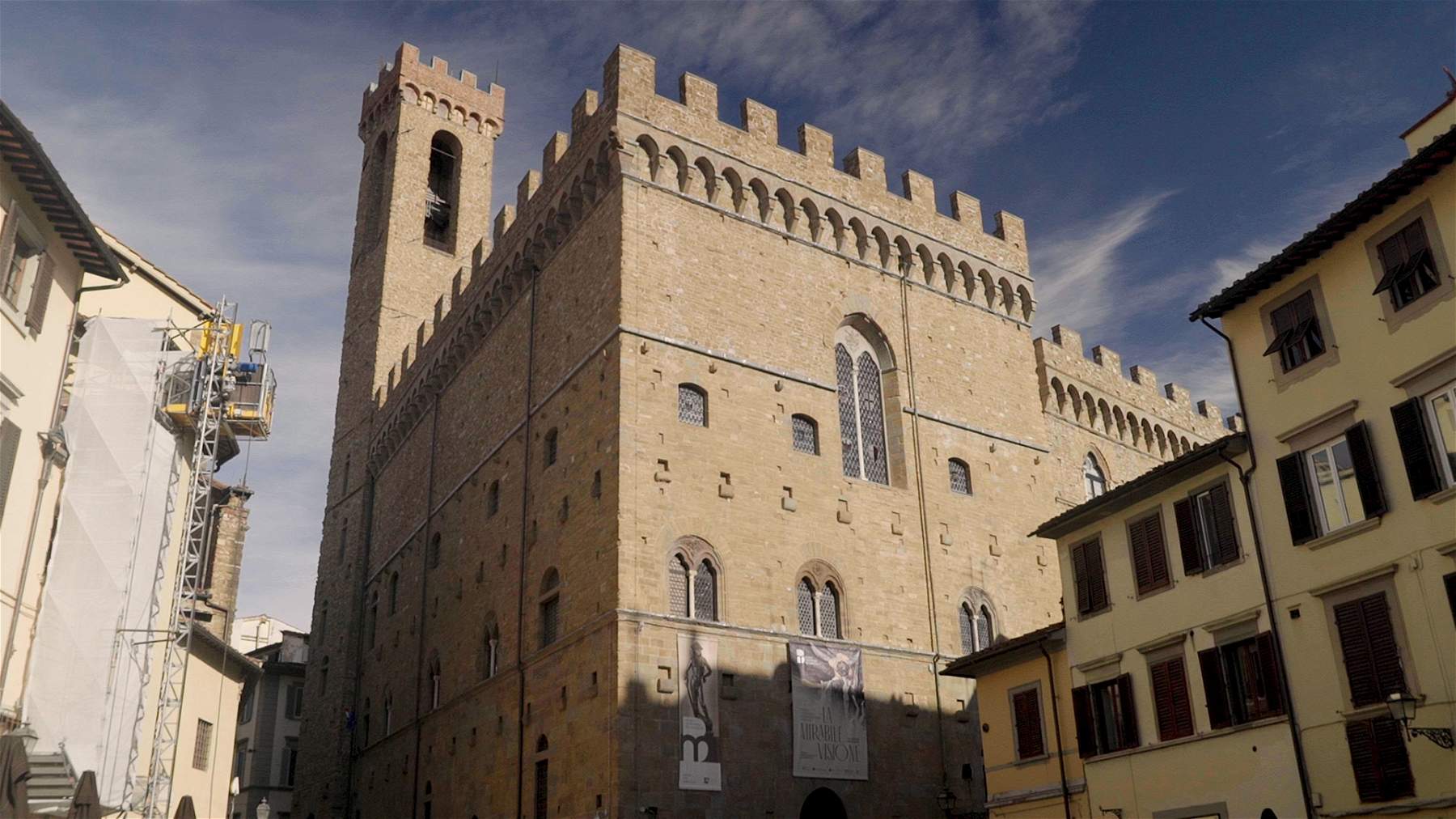 The Bargello
The Bargello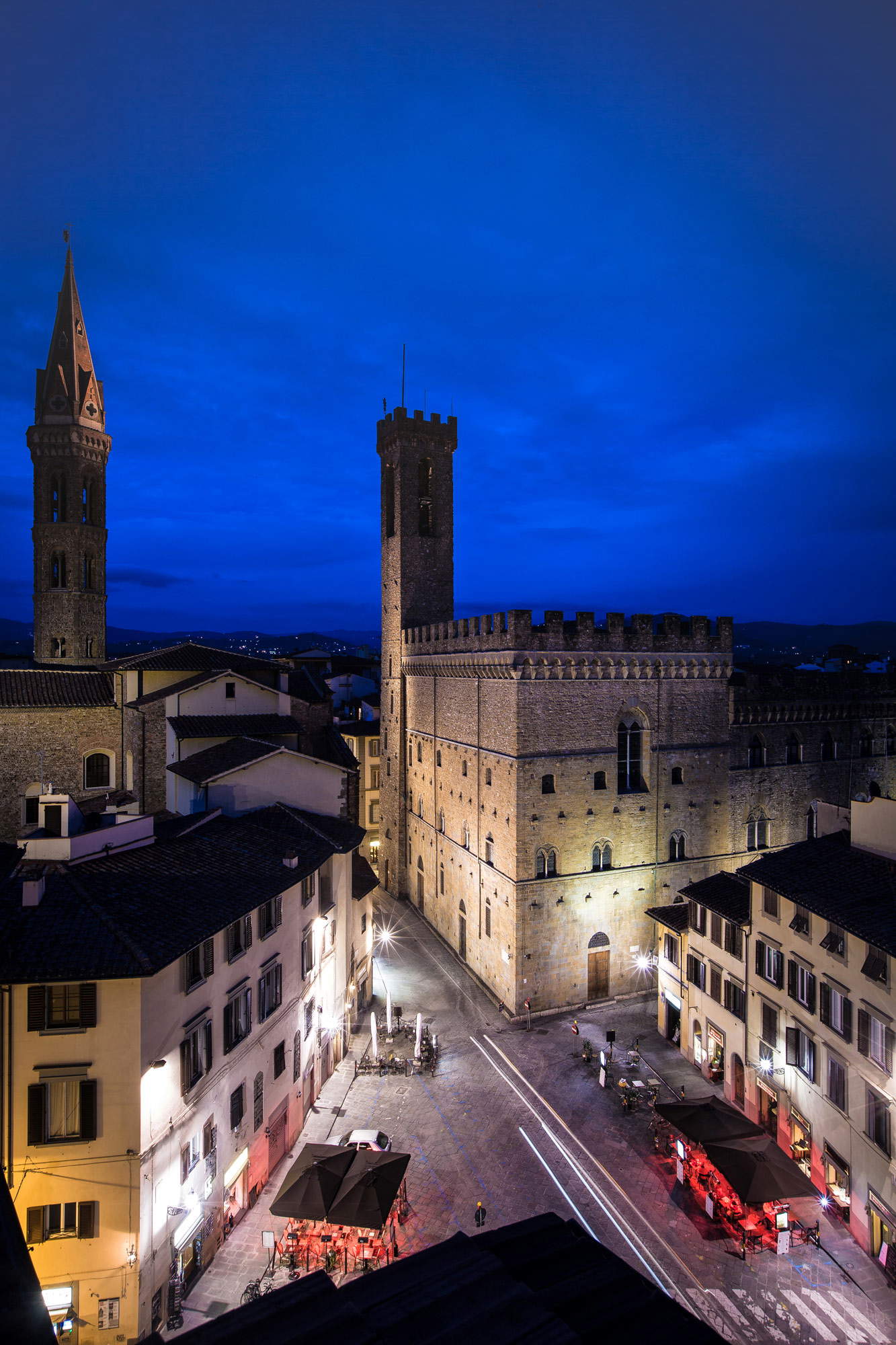 The Bargello
The Bargello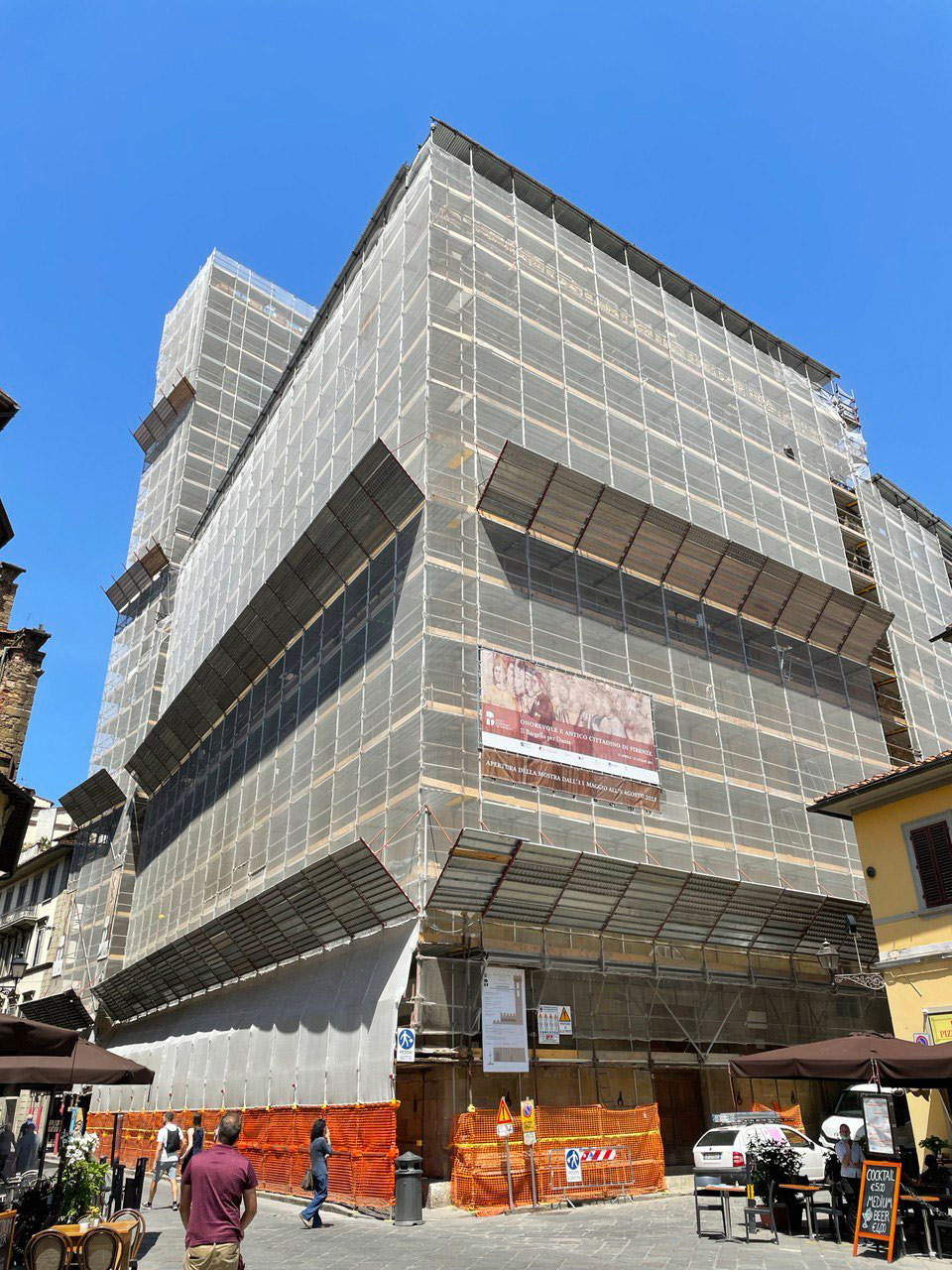
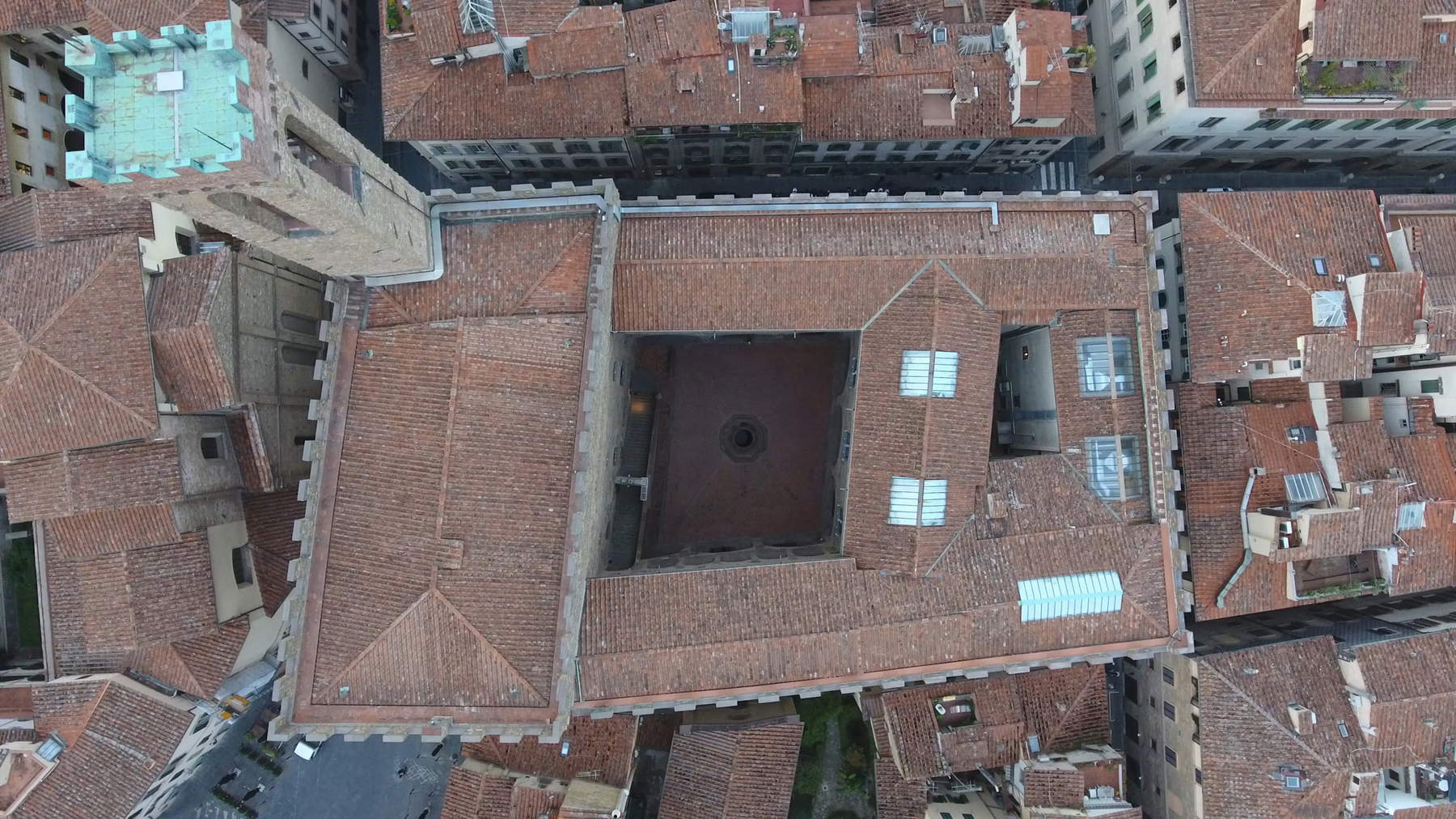 The Bargello
The Bargello Scaffolding
ScaffoldingThe need to adjust the progression of the work to the needs of the Bargello Museum, which has seen two forced and prolonged closures to the public due to the provisions put in place to counter Covid 19, led to a redefinition of the timing of the intervention lots and allowed for a rotation of scaffolding material such as to minimize costs and time of supply and transport. Thus, it was decided to intervene immediately on the courtyard taking advantage of the absence of the public due to the closures for the pandemic containment measures, and thus to take advantage of theentire daily working hours and then continued with the exterior facades and the Volognana tower (one of the tallest in the historic center, at 55 meters), on which it was possible to work even when the museum had resumed its usual opening hours to visitors.
The huge surface of pietra forte and pietra serena that characterizes the corpus of the Palace, from the lowest part of the facades to the top of the battlements, was cleaned, hammered (i.e., its strength was checked stone by stone) and consolidated where necessary. Inside the courtyard, thanks to the help of scaffolding, a thorough cleaning of the stone face and artifacts was carried out, including the coats of arms, which were restored directly on site, without being lowered to the ground. Also restored were the building’s more than one hundred windows, which required “tailor-made” interventions depending on the type (wooden windows or iron-framed glazing), which now provide a seal against water infiltration. In some cases, such as for the stained glass window in the Donatello Hall and those in the Magdalene Chapel, it was necessary to proceed with the construction of new frames and thus the complete disassembly of the windows themselves. In particular, for the Salone’s stained glass window, a new frame was made shaped on the decorative elements of the window, an operation that required great skill in both the disassembly and reassembly stages, given its considerable size (it is 5.40 meters high and composed of two panels each 1.10 meters wide). The large masonry mullioned window had been made by Benci di Cione in 1345 and like so many parts of the Palace has undergone extensive restoration over time. Finally, special treatment was given to the tower and belfry, which, in addition to being restored, cleaned and consolidated saw the pictorial restoration of the painted coats of arms and the rampant lion placed on top.
Thanks to the restoration campaign, it was possible to map centimeter by centimeter the entire surface of the Palace, an operation that made it possible to discover some “secret” details, impossible to see from below and with the naked eye. Such as the “signatures” of the stonemasons who over the centuries worked on the construction or maintenance of the building, but also the traces of painting (such as the one that emerged on the window frames of the courtyard) or the dates engraved in the stone, the ornamental details carved in the marble capitals and in the pietra forte, all pieces of the rich and stratified history, almost eight centuries long, of one of the oldest and most important palaces in Florence.
To illustrate to the public the result of this extraordinary restoration work and to tell the story of the ancient palace, Visivalab has created a short video in Italian and English, where the history of the monument and the collections is retraced, and where the restoration work is emphasized in detail.The video will be viewable online on the Bargello Museums YouTube channel, but also usable on-site thanks to a QR code that visitors will find upon arrival in the Bargello courtyard. During the months when the museum was closed, short videos were also made by Florence Movie Academy students that are also available on the Bargello Museums YouTube channel. The authors of the videos are students Elia Mansueto, Giovanni Perugi, Qinglu Tang, and Elena Elisabetta D’Anna Olivares who collaborated with museum curators and worked under the supervision of Lorenzo Galanti. Editing by Simone Cantini and production by Florence Movie Academy.
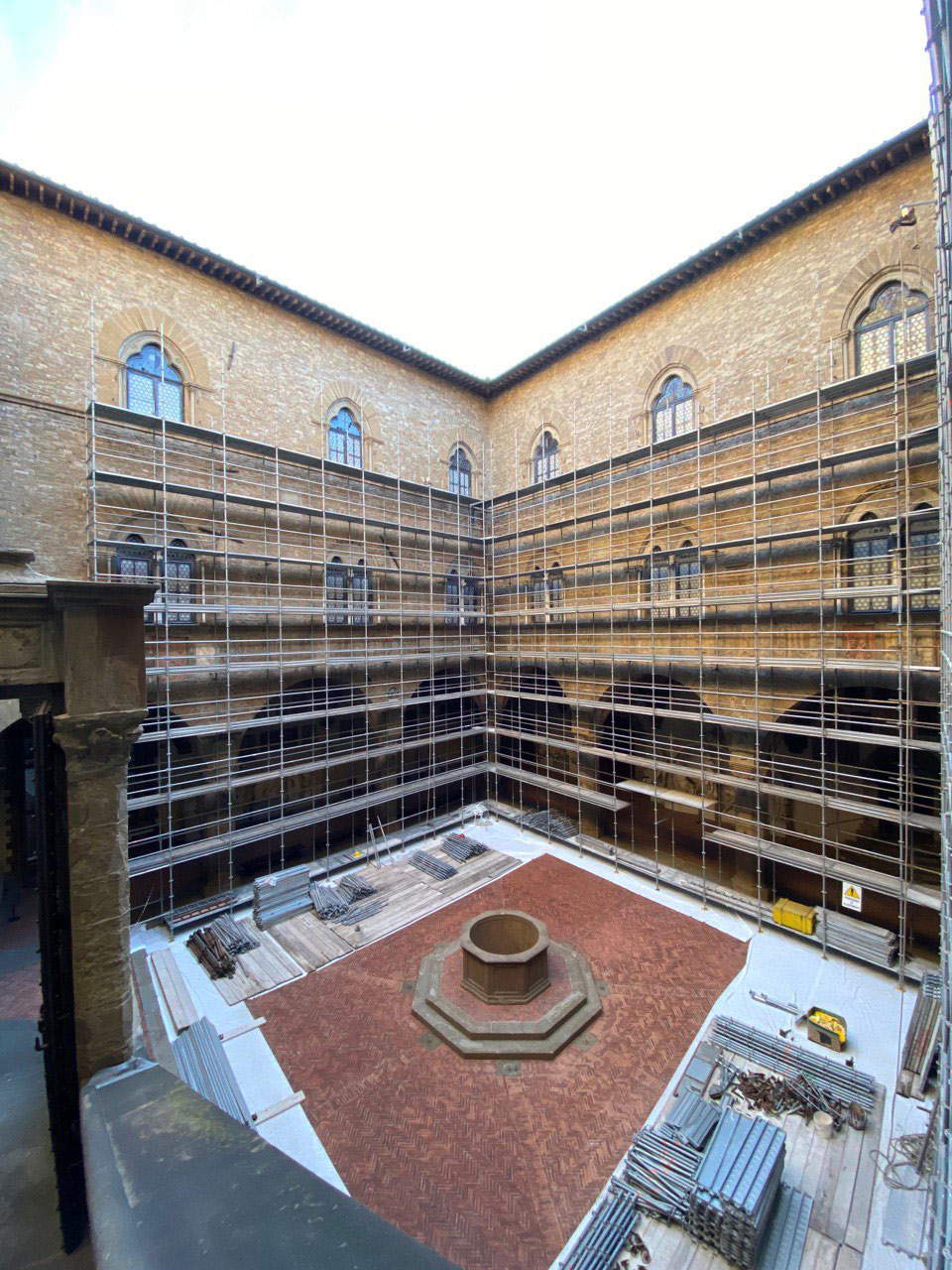

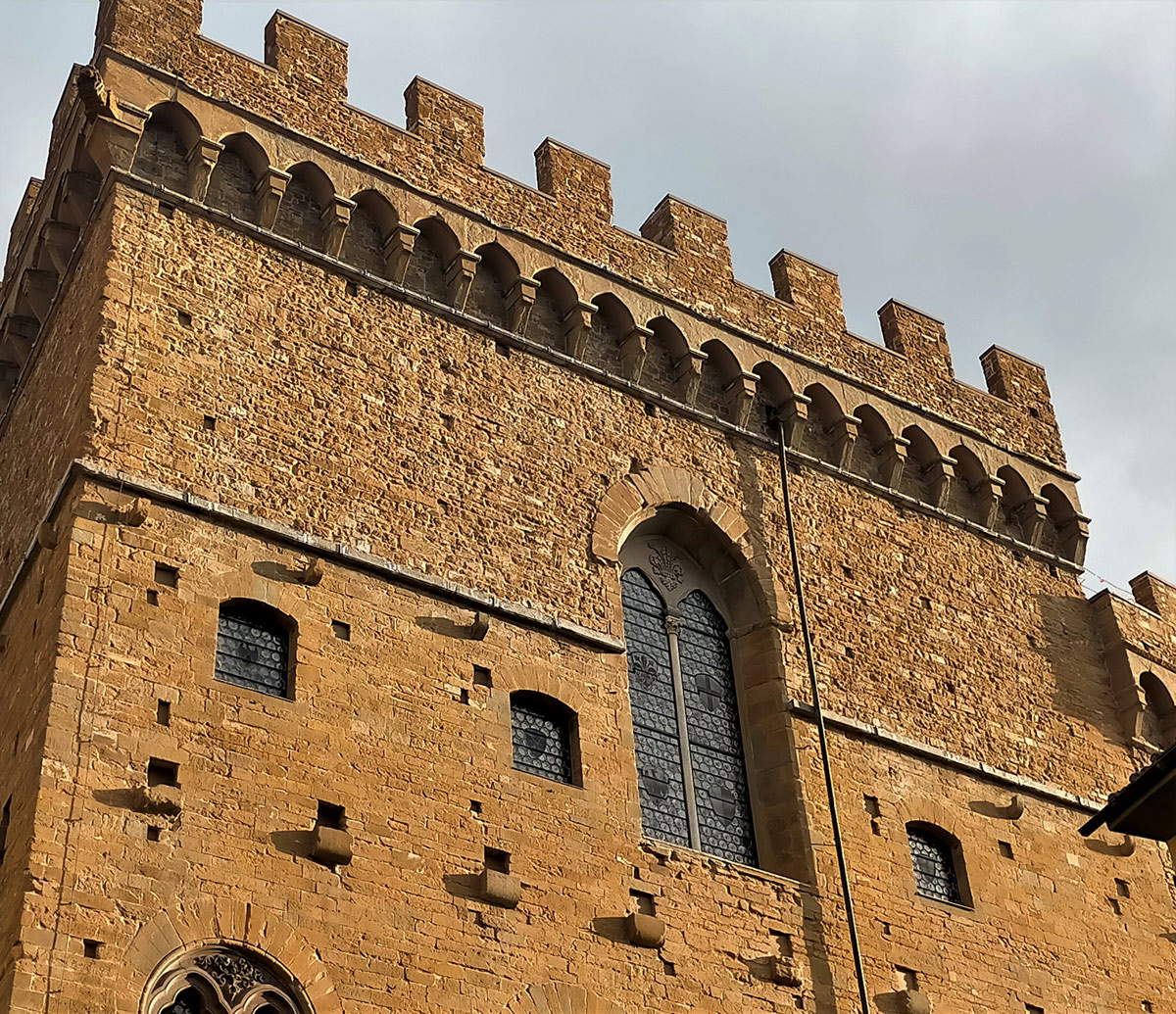


“This extraordinary campaign of restoration and conservative overhaul of the Palace,” explains Paola D’Agostino, director of the Bargello Museums, “is the result of more than four years of intense work by architect Maria Cristina Valenti in preparing the project and tender documents, assisted by the technical and administrative staff of the Bargello Museums, and then by the director of works and the contractors who took turns on site for these months, during a critical period for the entire world. Thanks are due to all the staff of the Bargello National Museum who supervised the work and ensured security during the long period of forced closure of the Italian Museums. This achievement, characterized by a strong commitment to the protection of the historic building, is the result of our joint work and that of the General Directorate for Museums and the General Directorate for Budget, which I particularly thank.”
“The Bargello is beautiful again,” says Mayor Dario Nardella, “thanks to a careful restoration carried out in record time. For the first time in a century and a half we will be able to visit a palace that has been completely upgraded and enhanced. This is an important signal for the city and for all our cultural heritage: despite the pandemic, the world of culture did not stop and indeed took advantage of the forced stop to invest and plan for the future.”
“The protection and enhancement of Italy’s monumental heritage are among the priorities of the General Directorate of Museums, which, even over the past year, has planned a series of extraordinary interventions for the entire National Museum System together with the activation of planned maintenance projects,” emphasizes General Director of Museums Massimo Osanna. “I visited the Bargello National Museum in September 2020, when the scaffolding in the courtyard had just been erected, and I am pleased on this occasion to appreciate the work done both in securing the windows and in restoring a building of such historical and artistic value, which has thus unveiled so many previously unseen details and refined details of the 14th-15th century ornamental party.”
“I remember that when the Bargello Museum reopened to the public in August 2020,” comments Maria Cristina Valenti, Single Project Manager and head of the technical office of the Bargello Museums, “there were already scaffolding in the courtyard; the first visitors, intrigued, commented wryly that they liked the scaffolding but who knows how much longer it would remain. Today I could proudly reply to those same visitors that we managed to finish the work in record time if you consider that in the courtyard the scaffolding was dismantled in December 2020 and the entire construction site was dismantled in October this year. The result we can admire today is the result of great synergy among the workers involved in this operation. To my great satisfaction, the Bargello Palace now shines again not only as a container for works of art, but itself as a work of art and architecture.”
“Restoring the 12.630 square meters of stone surface, facades, tower, courtyard of the Palace, for us who have lived it daily is something that went beyond the technical intervention,” explained the director of works, Giancarlo Lombardi, “this particular ’skin’ of strong stone, tells itself, tells its long life by showing itself through, the diversity of masonry texture, the almost invisible decorations of the window arches, the oxidation of the stone aftermath of the fires, and the many signatures of the stonemasons who made it up, so many are the elements that allow the reading of thesoul of this skin of the palace, certainly in need of great care and attention because the degradation of strong stone is very sensitive to climatic and environmental agents, this has been the main task of this construction site, a construction site in Covid times where, only the very strict coordination between the executors and their high professionalism allowed the execution of the many types of planned and unforeseen work in the 425 days that were needed to allow the palace to continue its journey.”

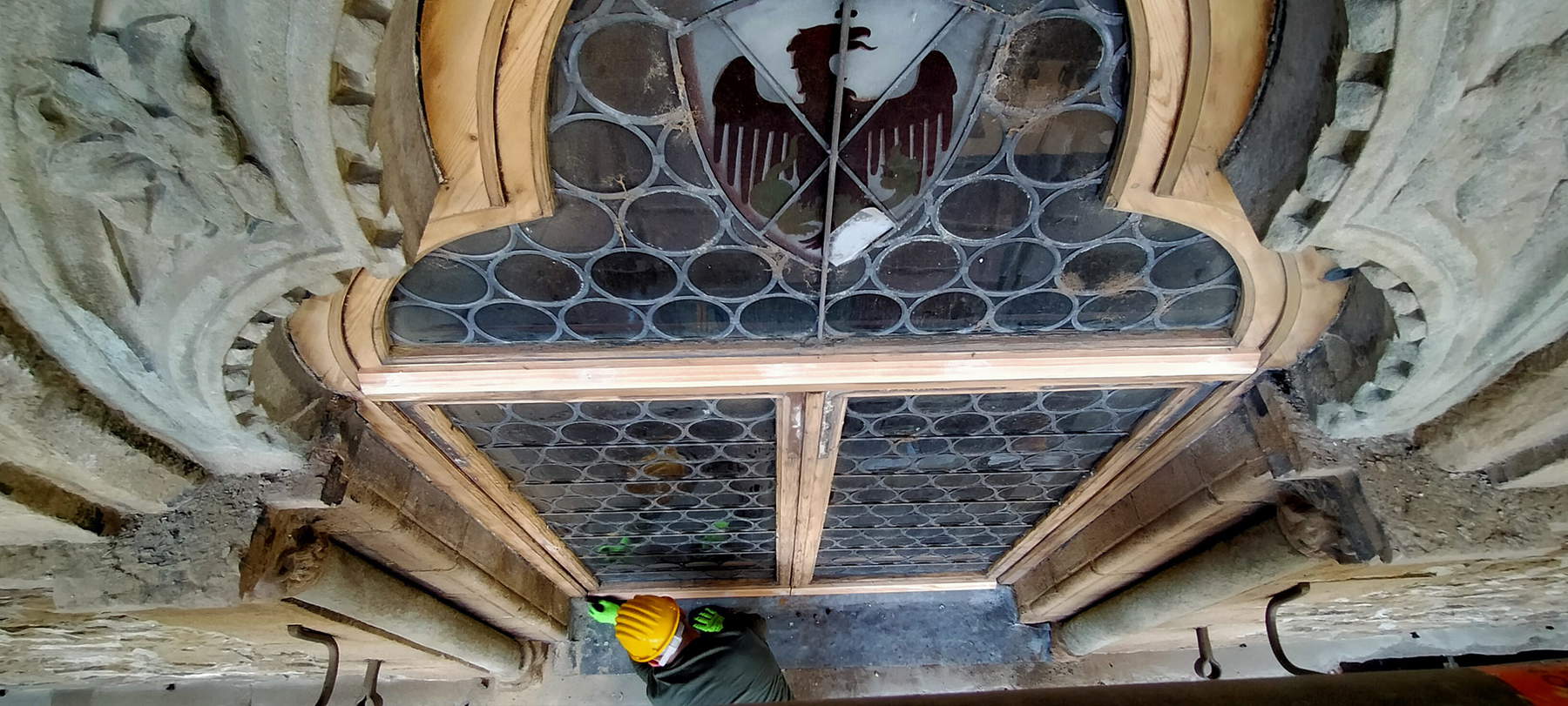 The
The
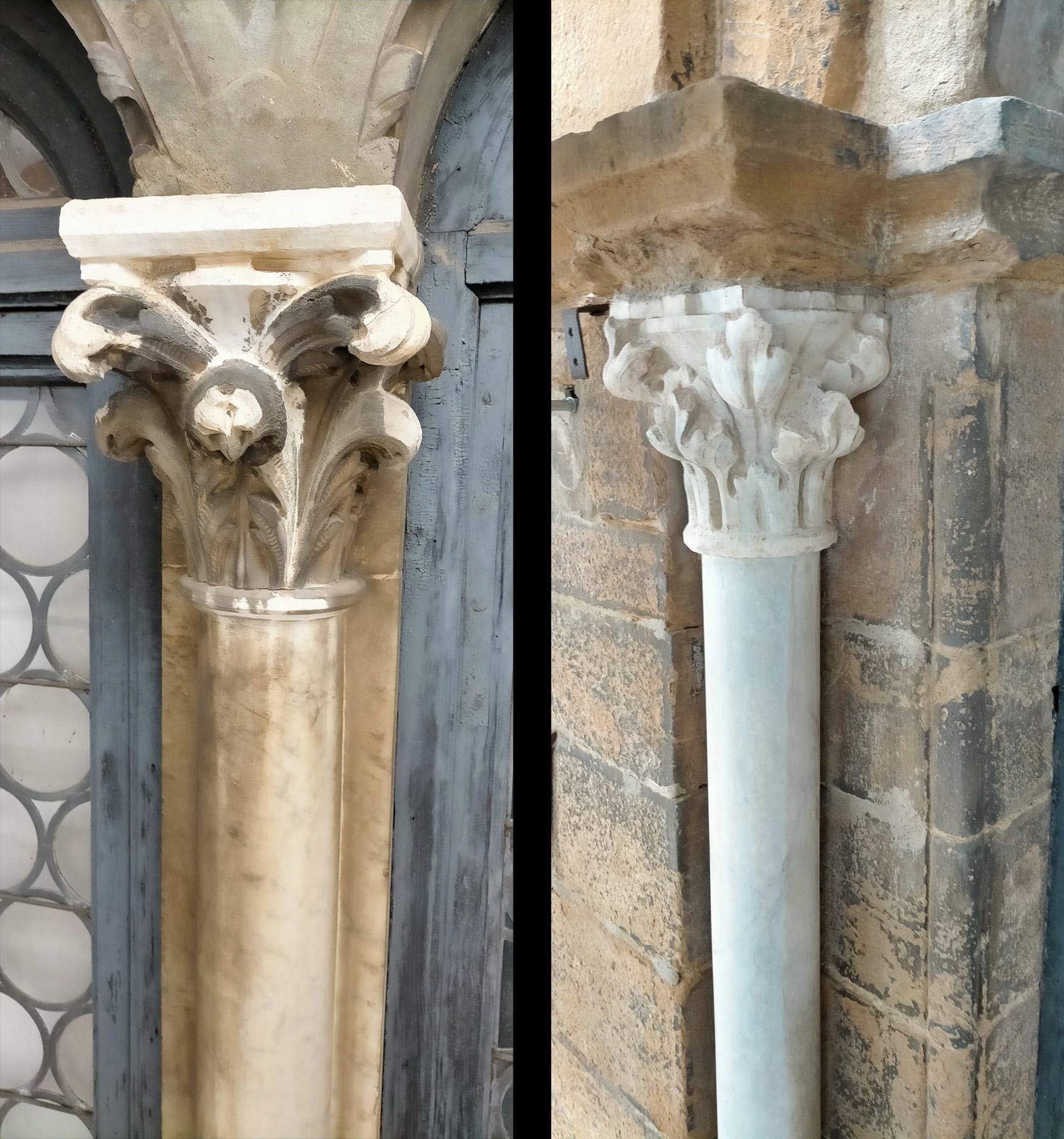
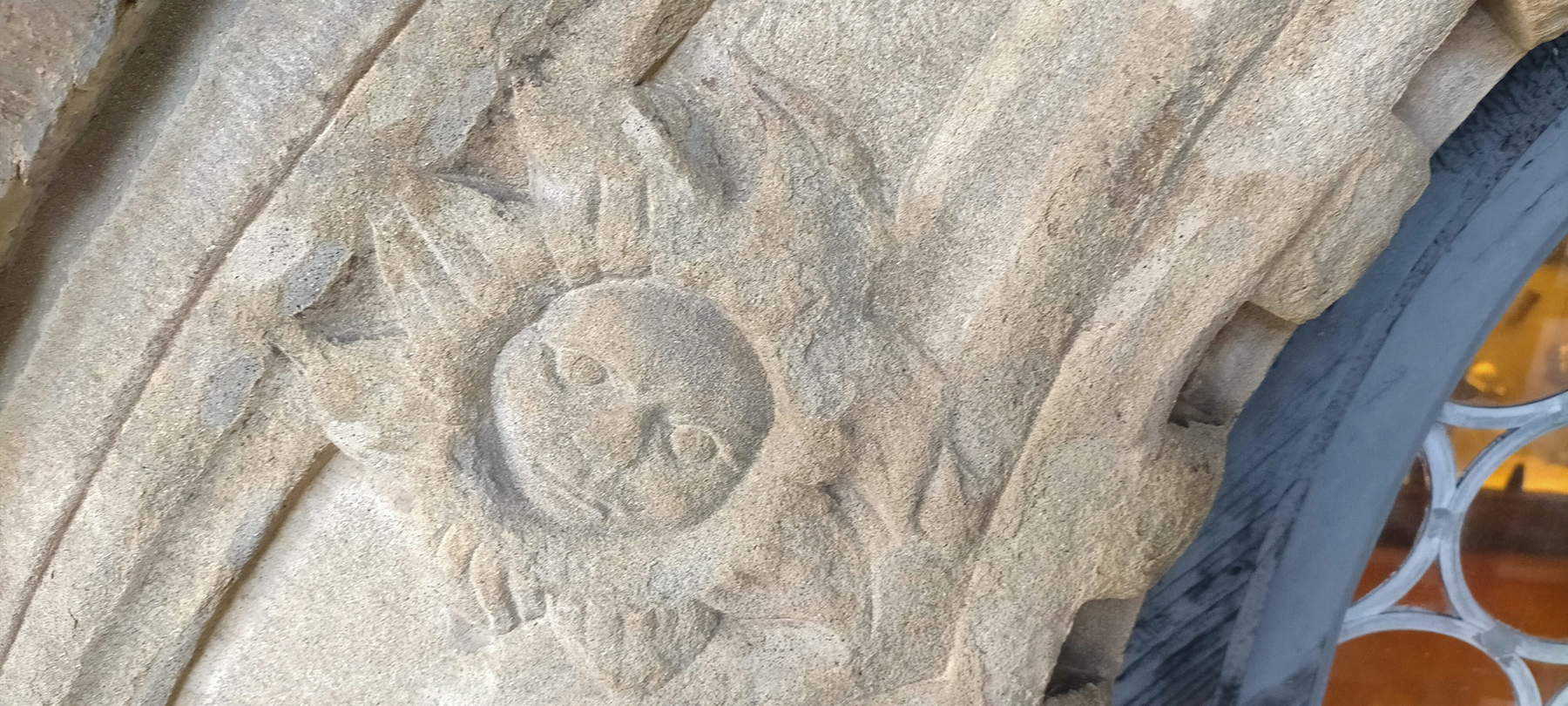
During the 13th century, at the birth of the commune of Florence, the city was endowed with new political figures and places of power. It was in 1255 that the construction of the Bargello Palace began. The building is the seat of the Podestà, whose coats of arms still adorn the courtyard. The palace is also the place where traitors to the Commune are judged, where Dante in 1302 is sentenced to death and then to exile. The first core of the building, incorporating the Volognana tower, evolved over time. In 1332 there was a very serious fire and in 1333 the flood devastated it, as reported in the chronicles of Giovanni Villani. Restoration and new decorative campaigns began soon after, also under Giotto’s supervision. A staircase is arranged on the west side: built between 1347 and 1365, it is embellished with a 16th-century iron gate designed by Giuliano da Sangallo. The staircase leads to the veron, embellished with ribbed vaults.
Biforas and single-lancet windows adorned with marble open onto the courtyard as early as the mid-14th century. In 1574, under Cosimo I, the building was used as a prison and became the headquarters of the Bargello, the chief of police. The rooms were divided into cells, the arches of the courtyard plugged, the frescoes whitewashed. Those rooms bearing witness to a glorious past were obscured, until in 1840 a new light emerged from the rediscovery of the frescoes in the Magdalene Chapel, the work of Giotto and his workshop. Dante’s portrait, frescoed among the elect in Paradise, becomes a destination for scholars, and decides the fate of the building (the fresco, moreover, was restored just in 2021). The curtain walls were torn down, the frescoes were freed, and the rooms were redecorated according to neo-Gothic taste. By royal decree of June 22, 1865, the Palace became Italy’s first National Museum dedicated to the arts of the Middle Ages and Renaissance.
 |
| Florence, ends extraordinary restoration of Bargello Palace |
Warning: the translation into English of the original Italian article was created using automatic tools. We undertake to review all articles, but we do not guarantee the total absence of inaccuracies in the translation due to the program. You can find the original by clicking on the ITA button. If you find any mistake,please contact us.